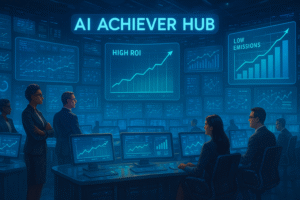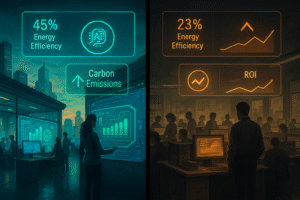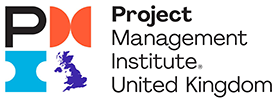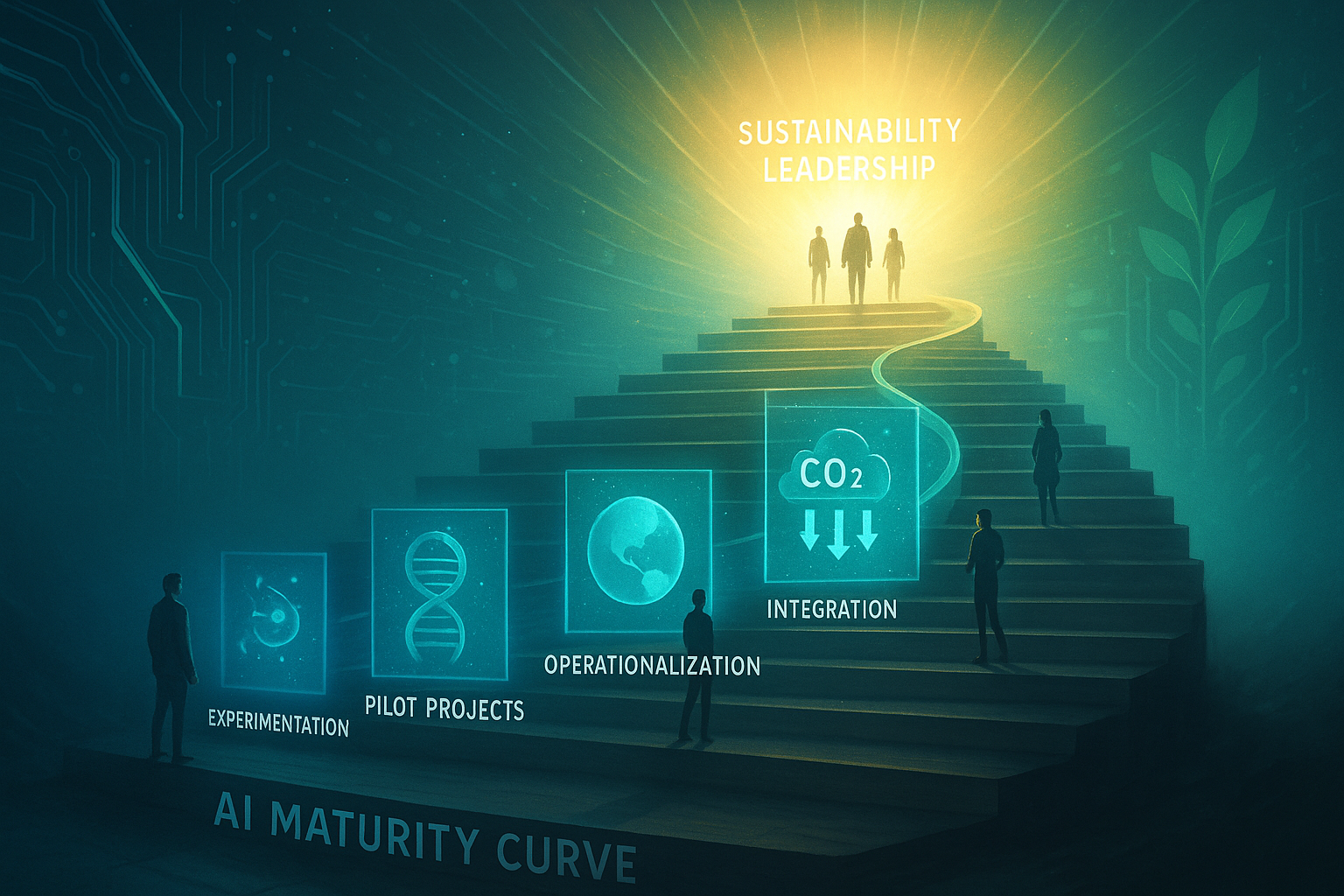The journey of integrating Artificial Intelligence (AI) with sustainability is not a uniform path, nor does it yield identical results for all organizations. A critical insight is that the extent to which businesses successfully leverage AI for sustainability is strongly linked to their overall maturity in adopting and integrating AI technologies. Following our exploration of AI’s applications and synergistic potential, this article examines this connection and the capabilities needed to move up the AI maturity path.
Companies progress through distinct stages of AI adoption, and their ability to achieve meaningful sustainability outcomes significantly increases as they advance. This isn’t merely about having more AI tools; it’s about developing a more practical and well-integrated use of AI aligned with business goals. We will now explore how AI maturity stages correlate with success in Sustainability+AI projects and identify the essential investments organizations must make to progress.
Correlating AI Maturity Stages with Sustainability+AI Project Success
A strong positive correlation exists between an organization’s AI maturity level and its reported success in sustainability initiatives that leverage AI. Organizations typically evolve through stages such as Experimenting/Exploring, Piloting, Adopting/Building, and ultimately Integrating/Achieving/Scaling.
 The Difference in Performance Is Clear:
The Difference in Performance Is Clear:
A significant difference in outcomes is evident between leaders and laggards in AI maturity. For instance, organizations identified as leaders in integrating AI and sustainability achieve average CO2 reductions of 26%, compared to just 3% for laggards. This stark contrast underscores the tangible benefits of higher AI maturity.
“AI Achievers” Outperform:
Mature organizations, such as “AI Achievers”—identified in Accenture’s 2022 report as the top 12% of firms—attribute nearly one-third of their revenue to AI and enjoy 50% higher growth than their peers, consistently outperforming in sustainability. Similarly, companies prepared to transform (16% of firms in a 2024 study) achieve 2.5 times higher revenue growth and are 3.3 times more successful at scaling generative AI.
Project-Specific Success Amplified by Maturity:
The impact of maturity is clear at the project level. Organizations at the “Integrating” stage of AI adoption report 31% success rates in energy efficiency initiatives, compared to only 8% for early-stage adopters. One logistics firm cited by PMI Brightline improved route efficiency by 23% using predictive AI, cutting both fuel costs and emissions.
Governance as a Maturity Indicator:
Higher levels of AI governance maturity, often accompanying overall AI maturity, correlate strongly with broader AI usage across functions (3x more likely) and higher revenue growth (nearly 5%). While 73% of firms increased AI deployment in 2023, only 35% had strong governance in place—highlighting a critical maturity gap (Consultancy.com.au).
“Success” in this context encompasses achieving tangible sustainability outcomes, successfully scaling initiatives beyond pilots, and realizing measurable business value. A framework illustrating this relationship details characteristics, reported success rates, capabilities developed, and common challenges at each stage. This shows, for example, that “Experimenting” stage firms have minimal impact and low success rates (e.g., <8% in energy efficiency), while “Integrating/Achieving” stage firms demonstrate significant, measurable impact (e.g., >20% CO2 reduction) and high success rates (e.g., >30% energy efficiency).
 Returns on investment often increase disproportionately as organizations reach higher maturity levels, where substantial impacts are unlocked only at higher maturity levels, implying that sustained commitment is required. Furthermore, the definition of “AI maturity” is dynamic, increasingly incorporating readiness for Generative AI.
Returns on investment often increase disproportionately as organizations reach higher maturity levels, where substantial impacts are unlocked only at higher maturity levels, implying that sustained commitment is required. Furthermore, the definition of “AI maturity” is dynamic, increasingly incorporating readiness for Generative AI.
Essential Capabilities and Investments for Advancing Maturity and Outcomes
Progressing along the AI maturity curve to achieve superior Sustainability+AI outcomes necessitates building the right internal capabilities and prioritizing investments that drive change.
Key Organizational Capabilities:
- Strategic Alignment and Vision: A clear AI strategy explicitly linked to business and sustainability goals is fundamental. AI readiness enhances dynamic capabilities.
- Leadership and Sponsorship: Strong C-suite and board commitment is critical for resources and driving adoption. CEO oversight of AI governance correlates with GenAI impact.
- Data Foundation (Data Readiness): This is arguably the most critical technical foundation, encompassing robust data governance, quality, accessibility, integration, and metadata management.
- Technology Infrastructure: Access to scalable and flexible technology platforms, appropriate AI tools, and robust integration capabilities are necessary.
- Talent and Skills: Access to specialized AI/data science expertise combined with sustainability domain knowledge, alongside broader workforce upskilling, is crucial.
- Organizational Culture: A successful AI journey depends on cultivating a workplace that values informed decisions, teamwork, and adaptability.
- Governance and Risk Management: A clear AI governance framework, ethical guidelines (Responsible AI principles), and risk management processes are non-negotiable.
- Process Integration and Workflow Redesign: Embedding AI into core processes, often requiring fundamental redesign, is key for mature adoption.
- Organizational Flexibility and Agility: The ability to adapt strategies and operations quickly is vital.
Necessary Investments:
Advancing these capabilities requires dedicated investment in:
- Technology platforms, AI tools, and cloud services.
- Data infrastructure, data management systems, and data quality initiatives.
- Talent acquisition, retention, and comprehensive training programs.
- Formal change management initiatives.
- Establishing and maintaining governance structures and compliance mechanisms.
Building AI maturity for sustainability is about developing a holistic set of organizational capabilities, not merely acquiring technologies. Technology on its own can’t drive impact—it must be supported by the right strategy and people. There’s also a mutually reinforcing relationship between AI maturity and an organization’s capacity for change.
Key Takeaways for Leaders
The analysis of the AI maturity curve offers critical guidance for business leaders:
- A direct and significant correlation exists between an organization’s AI maturity level and its ability to achieve substantial sustainability outcomes, as evidenced by performance gaps between leaders and laggards.
- Advancing along the AI maturity curve is not just a technological endeavor but a holistic organizational transformation requiring strategic investments in data readiness, talent, culture, and governance.
- Simply “dabbling” in AI for sustainability may yield limited results; significant and transformative impacts are typically unlocked only at higher levels of AI maturity, demanding sustained commitment and strategic investment.
- The capabilities required for AI maturity are continuously evolving, particularly with the rise of Generative AI, necessitating ongoing adaptation of strategies and capability-building efforts.
Conclusion: Ascending the Curve for Sustainable Leadership
Achieving leadership in AI-driven sustainability is intrinsically linked to an organization’s position on the AI maturity curve. The journey from initial experimentation to full-scale integration and strategic impact requires more than just technological adoption; it demands a concerted effort to build deep organizational capabilities.
Organizations that strategically invest in advancing their AI maturity—by fostering strong leadership, building robust data foundations, cultivating talent, nurturing an adaptive culture, and implementing sound governance—are not only better equipped to harness AI for sustainability but are also positioning themselves for superior overall business performance and resilience. As PMI–Brightline emphasizes, organizations leading in this space treat AI and sustainability as a unified transformation, not siloed efforts. The path to becoming an “AI Achiever” in sustainability is an ongoing effort that requires focus, adaptability, and long-term planning, but the rewards are substantial.
In our next article, we will delve into “Enabling Success: The Pillars of Effective Sustainability+AI Integration,” to explore the foundational elements crucial for any organization embarking on this transformative journey.
References
- PMI: Sustainability in the Age of AI – The Integration Imperative
https://www.pmi.org/-/media/pmi/documents/public/pdf/learning/thought-leadership/brightlinesustainabilityai20250403.pdf
- The Art of AI Maturity: Advancing from Practice to Performance
https://www.accenture.com/ca-en/insights/artificial-intelligence/ai-maturity-and-transformation
- Twin Transformation: How AI and Sustainability Drive Competitive Advantage
https://www.rolandberger.com/en/Insights/Publications/Twin-Transformation-How-AI-and-sustainability-can-drive-competitive-advantage.html
- AI adoption is outpacing AI governance, leaving organisations exposed to risks
https://www.consultancy.com.au/news/10423/ai-adoption-is-outpacing-ai-governance-leaving-organisations-exposed-to-risks - Superagency in the workplace: Empowering people to unlock AI’s full potential
https://www.mckinsey.com/capabilities/mckinsey-digital/our-insights/superagency-in-the-workplace-empowering-people-to-unlock-ais-full-potential-at-work
About the Author:
Merv Wyeth, Sustainability Community of Action (SCoA) Lead
Sam Leung, Sustainability Community of Action (SCoA) Member
Leila Moses, Sustainability Community of Action (SCoA) Member


